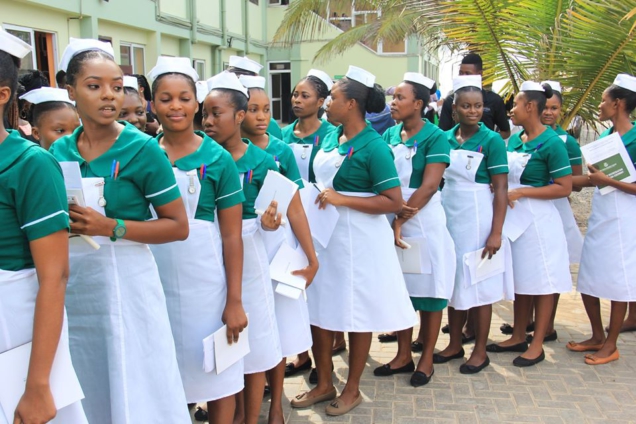Ghana's health workforce represents about 67% of the number needed for primary health care.
For six health care professionals, it is less than 50% of what is required. This trend is likely to persist until 2035 if no action is taken.
This is according to research conducted by three scientists, Dr James Avoka Asamani of the World Health Organization, Dr Christmal Dela Christmals, and Prof. Gerda Reitsma, both at the North-West University in South Africa.
The research which was published in the Public Library of Science journal, PLOS ONE on 28 September 2021 also reveals that the country needs at least 221, 593 health professionals across eleven categories in primary health care.
That number required would grow up to 495, 273 by 2035.
Currently, the country’s stock of health workers is about 148, 390, growing at 5.6% annually. By 2035, the total number of healthcare workers could rise to 333,770.
Using a need-based analysis of the country’s population, disease burden and a nationally representative sample to assess the service delivery practices of health workers, the study revealed that the country has 12, 786 midwives or 91.3% instead of 14,002
According to the scientists, by 2025, there would be an excess of 7,170 midwives, which would be more than a 40% surplus as a result of the current rate of training midwives.
For doctors, there is a deficit of 7,876 (or 56% shortage); 6,962 shortage of professional general nurses (10.4% shortage); 3,226 shortage of medical laboratory scientists (70.4% shortage) and 2,941 deficits for pharmacists (73.7% shortage).
For the Community-based Health Planning and Services (CHPS) policy to succeed, there is an urgent need for an additional 17,293 community health nurses where the shortage was 41.4%.

The study recommended Ghana’s health workforce strategy increase intake of Pharmacy Technicians by more than seven-fold, General Practitioners by 110%, Registered general Nurses by 55%, whilst Midwives training is scaled down by 15%.
However, an investment of about US$ 480.39 million is required to correct the gaps identified.
At least US$ 158 million (up to US$ 2.374 billion by 2035) must also be budgeted for the health sector payroll to employ and sustain existing employees.
Lead author, Dr Asamani tells JoyNews, the study is the first of its kind to be conducted in Ghana using population needs-based analysis that included more than 95% of the causes of illness, injuries, risk factors and deaths.
He said the findings are not entirely surprising.
"It corroborates previous works and evidence that Ghana is closing in on its health workforce needs, but more work must be done," he said.
He however added that, as Ghana is on the list of safeguard countries by the World Health Organization, a comprehensive health labour market analysis is essential to engage all stakeholders nationally and internationally.
A Ghanaian scientist at the Centre for Health Professions Education at the North-West University in South Africa, Dr Christmals notes that given fiscal space challenges, the government needs to actively pursue opportunities to export nurses and midwives.
The study covers 11 categories of health workers including Community Health Nurse, General Practitioner (General Doctor), Laboratory Scientist and Technician.
Others are; Midwife, Nutritionists, Dieticians and Pharmacists.
The rest are Pharmacy Technician, Physician Assistant (Medical) and Registered General Nurse.
Latest Stories
-
30 suspects arrested as IGP orders raids on galamsey hotspots in 3 regions
16 minutes -
BlowChem announces price reductions on beverages, effective June 1
1 hour -
When lawmakers themselves appear unwilling to abide by the laws they legislate
5 hours -
Mahama promises 200,000-hectare cocoa expansion to revitalise industry
5 hours -
Communications Minister unveils gov’t’s digital inclusion plan for PWDs
5 hours -
Youth group accuses judiciary of undermining anti-corruption efforts
5 hours -
Parliament recommends ratification of WTO agreement on fisheries subsidies
5 hours -
Ghana to roll out Labour Export Initiative – Mahama announces
5 hours -
Two killed in fatal accident on Bole–Damongo Road
6 hours -
Joseph Ade Coker, former NDC Greater Accra Regional Chairman dies
6 hours -
From Bulldozing to Bail-Begging: Wontumi’s Plot Twist No One Saw Coming
6 hours -
Mahama promises new modern regional hospital for Ahafo Region
6 hours -
Appiagyei-Atua: Protest by Minority over Wontumi’s arrest unnecessary and theatrical
6 hours -
Parliament approves GH¢10bn for NHIA
6 hours -
Martin Kpebu alleges some NPP bigwigs exploiting Wontumi’s arrest for political gain
7 hours

